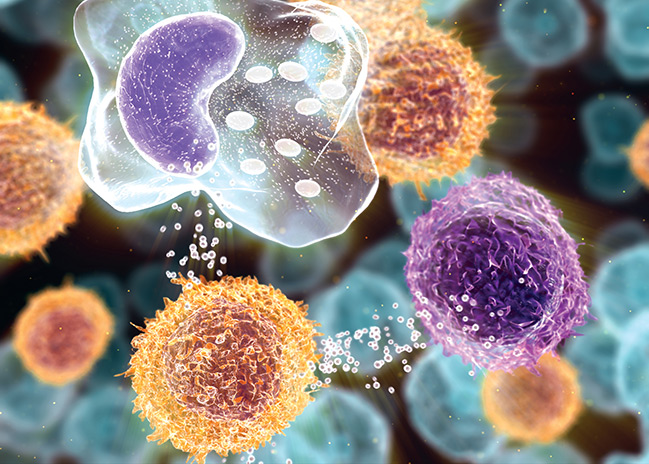 By Theo Klein, the lead author and PDF in Overall Lab
By Theo Klein, the lead author and PDF in Overall Lab
A collaboration between the labs of Chris Overall at the CBR, Stuart Turvey at the Child & Family Research Institute, and Mike Gold in I3 at the LSI, investigated a unique mutation in the MALT1 gene. This lead to a patient that paradoxically had a poor response to infection and displayed autoimmune symptoms.
The paper was recently published in Nature Communications and highlights the innovative proteomics research undertaken in the CBR to understand the actions of white blood cells.

B cells communicate via cytokines with other inflammatory cells. Photo credit: F. Hoffmann-La Roche Ltd.
When B and T white blood cells recognize an antigen, a complex signalling cascade is set in motion that activates these immune cells and allows them to deal with an invading pathogen or cancer. However, if the response is too strong then autoimmunity can result.
One of the key players in this cascade is MALT1, which acts like a pair of molecular scissors that inactivates inhibitors of the cascade, thereby boosting the activation of the immune cells.
By comparing B cells from the patient with a mutated MALT1 gene, to the B cells from healthy family members, a new protein target for MALT1 was discovered. It turns out that MALT1 also cuts a protein called HOIL1. Cleavage of HOIL1 stops other protein scaffolds, called linear ubiquitin, from being assembled and in turn dampens the immune response.
We already knew that MALT1 activity causes enhanced activation of the immune cells, but the discovery that it also acts as an inhibitor of the cascade was extremely surprising. This finding also partially explains the symptoms of the patient: failure to properly shut down B and T cell responses, leading to inflammation and autoimmunity, as well as poor immune response. Since MALT1 is under investigation as a potential drug target in treatment of certain types of lymphoma, these findings may be crucial in advancing further development of these compounds.


